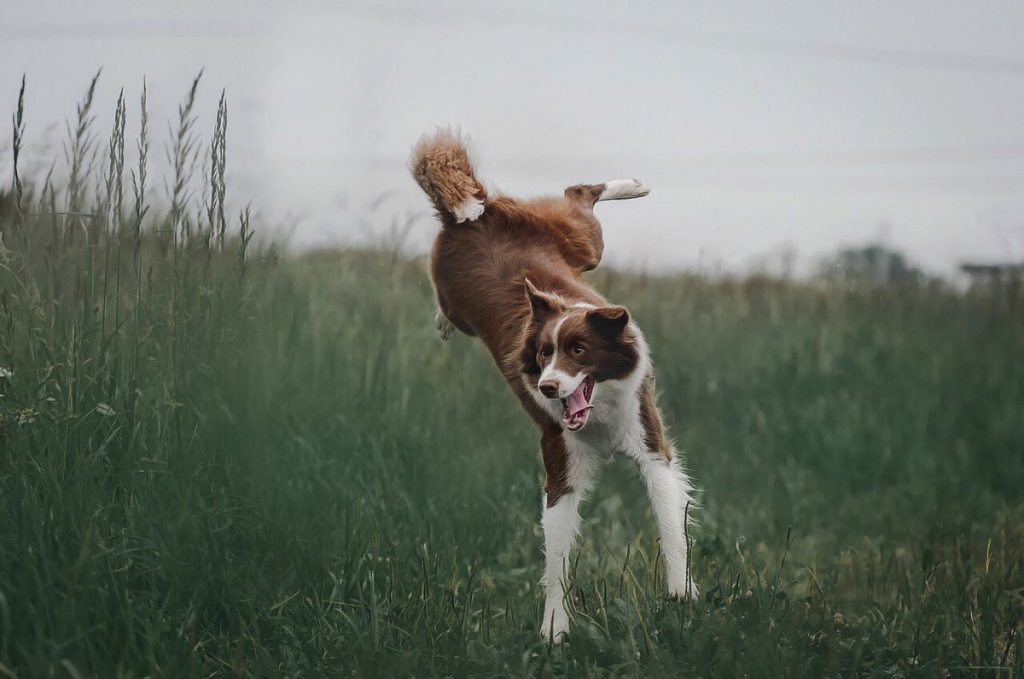Dogs are one of the most beloved creatures on this planet, with their wagging tails and adorable faces melting our hearts. But even the most well-behaved pups can exhibit some strange behaviors, such as humping the air. Yes, you heard that right – dogs can engage in this seemingly bizarre activity. But before you start questioning your furry friend’s sanity, let’s dive into the reasons behind why dogs hump the air.
In this blog post, we’ll delve into the fascinating world of air humping and uncover the various factors that may contribute to this behavior.
From natural instincts to potential medical issues, here are some key takeaways on why our canine companions engage in this peculiar activity:
- It’s a normal part of their development
- It can be a display of dominance or submission
- t may serve as a way to release pent-up energy
- Underlying medical conditions could also be a factor
- Training and redirection techniques can help manage the behavior
So, let’s start.
Why Do Dogs Hump The Air?
Table of Contents
Dogs may engage in the act of humping the air due to various reasons such as sexual arousal, dominance, playfulness, or heightened emotions. This natural behavior can be effectively addressed by understanding its underlying cause and redirecting it into more appropriate outlets.
One of the most common reasons for dogs humping the air is due to sexual arousal. This is particularly common in unneutered males who are seeking an outlet for their sexual energy. In such cases, neutering can prove to be highly effective in reducing this behavior.
Dominance can also play a role in this behavior. Dogs may hump the air to assert their dominance over other dogs or even their owners. With proper training and establishing yourself as the pack leader, you can effectively address this dominant behavior.
In some cases, air humping may also simply be a sign of playfulness or heightened emotions. However, it is important to redirect this behavior into more appropriate outlets such as playing with toys or engaging in physical activities.
Finally, addressing any underlying issues such as anxiety or fear can also help reduce excessive air humping in dogs. By providing them with a safe and secure environment and addressing any triggers that may cause this behavior, you can help your dog overcome this habit.
Overall, understanding the reasons behind why dogs hump the air and implementing effective measures to manage and redirect this behavior can help create a harmonious and happy relationship between you and your furry companion.
The Science Behind Air Humping in Dogs
The reasons behind air humping in dogs can vary, depending on the individual dog and situation. This normal behavior can serve as a way for dogs to communicate, express themselves, or release energy and stress.
In addition, biological factors such as hormones, genetics, and instincts may also play a role in this behavior.
| The Purpose of Air Humping | Biological Factors |
| To Release Energy | Changes in hormonal levels (such as an increase in testosterone) |
| To Relieve Stress/Anxiety | Inherited traits (certain breeds may be more prone to anxiety) |
| To Initiate Play | Natural instincts (playful behavior is crucial for socialization and development) |
| To Seek Attention | Social cues (dogs may hump to get attention from their owners or other dogs) |
| Medical conditions (humping may be a way for dogs to alleviate discomfort from urinary tract infections or skin irritations) |
It’s worth noting that air humping is not always linked to sexual frustration or aggression. Dogs engage in this behavior for various reasons, and it is a natural aspect of their behavior.
Reasons for Air Humping In Dogs
Dogs sometimes air hump for various reasons, such as feeling sexually aroused, displaying dominance, experiencing boredom, or having excess energy.
Understanding these underlying causes can assist dog owners in addressing this behavior by identifying and implementing appropriate solutions
For example, getting the dog neutered or spayed can reduce sexual arousal, while training and setting boundaries can address dominance-related humping. Providing ample physical and mental stimulation can also redirect excess energy and decrease boredom-related humping.
Additionally, creating a secure and stress-free environment can help reduce anxiety-related humping. By addressing the root cause of air humping, dog owners can effectively manage this behavior and improve their furry companion’s overall well-being.
Do Neutered Dogs Still Hump?
While neutering can greatly reduce the frequency and intensity of humping behavior in dogs, it is still possible for neutered dogs to exhibit this behavior. This can be due to a variety of reasons, including learned behavior, stress, excitement, dominance, or attention-seeking.
It is important for dog owners to understand that neutering does not completely eliminate humping behavior in all cases. Here is a table summarizing the potential reasons for humping behavior in neutered dogs and their solutions:
| Potential Reasons for Humping Behavior | Solutions |
| Learned Behavior | Training and redirecting towards appropriate behaviors |
| Stress/Anxiety | Creating a secure and calm environment, providing mental and physical stimulation |
| Excitement | Redirecting energy through exercise, training, and boundaries |
| Dominance | Establishing clear boundaries and training to discourage dominant behaviors |
| Attention-seeking | Ignoring the behavior and redirecting attention towards appropriate behaviors |
It is worth noting that neutering may not immediately eliminate humping behavior as it can take up to six weeks for excess testosterone levels to leave a dog’s body. However, with time, the frequency and intensity of humping should decrease significantly.
If the behavior persists or becomes excessive, it is recommended to consult with a veterinarian or professional dog trainer for further guidance.
When to Be Concerned About Your Dog’s Humping
Determining whether your dog’s humping behavior is cause for concern can be quite challenging, as there could be a variety of underlying reasons. However, here are some important factors to consider:
- Frequency and Intensity: If your dog is persistently or excessively humping, it could be a sign of an underlying medical issue, such as a hormonal imbalance or urinary tract infection.
- Context: Pay close attention to the context in which your dog is humping. For instance, if it only happens around certain objects or other dogs, it could be a learned behavior rather than a medical issue.
- Age: Take into account the age of your dog as well. Puppies may hump as part of their exploration and play behavior, while older dogs may do so due to cognitive decline.
- Aggression: If your dog is humping aggressively, like pinning down another dog, it could be a sign of dominance or territorial behavior that needs to be addressed.
- Changes in Behavior: If your dog’s humping behavior suddenly changes, it could be a sign of stress or anxiety. This is particularly important to consider if there have been recent changes in your dog’s environment or routine.
If you are unsure or concerned about your dog’s humping behavior, it is always best to seek guidance from a professional trainer or behaviorist. They can help determine the underlying reason for the behavior and provide appropriate solutions.
Additionally, if you notice any sudden changes in your dog’s humping behavior, it is crucial to consult with a veterinarian to rule out any medical issues.
How to Manage Air Humping in Dogs
| How to Manage Air Humping in Dogs: | Tips and Strategies for Reducing and Redirecting This Behavior |
| Effective Strategies: | Explanation: |
| Provide physical and mental stimulation | Dogs may hump the air as a way to release pent-up energy or anxiety. By ensuring they receive adequate physical exercise and mental stimulation, they are less likely to engage in this behavior. Engaging in interactive play and giving them plenty of opportunities to run and explore can help tire them out and reduce the urge to air hump. |
| Train for impulse control | Dogs that lack impulse control may be more prone to humping behavior. Teaching them to wait for permission before engaging in certain behaviors can help reduce the frequency of air humping. Start with simple commands like “wait” or “leave it” and gradually increase the difficulty level as they improve their impulse control. |
| Set clear boundaries and rules | Consistency is key when it comes to managing any type of behavior. Make sure everyone in the household is on the same page and follows the same rules when it comes to your dog’s behavior. This can include not allowing them to air hump or providing alternative behaviors that are acceptable. |
| Consult with a veterinarian | In some cases, excessive air humping may be a sign of an underlying medical issue. It is important to consult with a veterinarian to rule out any potential health problems. They can also provide advice on behavior modification techniques or medication if necessary. |
| Use deterrents | Squirting your dog with water or using other deterrents can be an effective way to interrupt the behavior and redirect their attention to something else. However, it’s important to never punish your dog physically or verbally as this can cause further stress and anxiety. |
| Be patient and consistent | It may take time for your dog to unlearn this behavior, but with patience and consistency, it is possible to reduce and even eliminate it completely. Continue to provide mental and physical stimulation, reinforce positive behaviors, and discourage air humping with gentle redirection and training. |
Also Read: Why Does My Dog Sleep Under The Bed?
Conclusion
In conclusion, the act of dogs humping the air may seem peculiar and even embarrassing, but it is a natural behavior with various underlying factors.
Whether it is driven by sexual arousal, dominance, or playfulness, understanding the reasons behind this behavior can help us effectively manage it. By providing appropriate outlets for their energy, setting clear boundaries, and addressing any underlying issues, we can foster a harmonious relationship with our furry companions.
Remember to seek professional guidance if you have concerns or notice sudden changes in your dog’s humping behavior.
With patience and consistency, we can assist our dogs in overcoming this behavior and thriving both physically and mentally.






